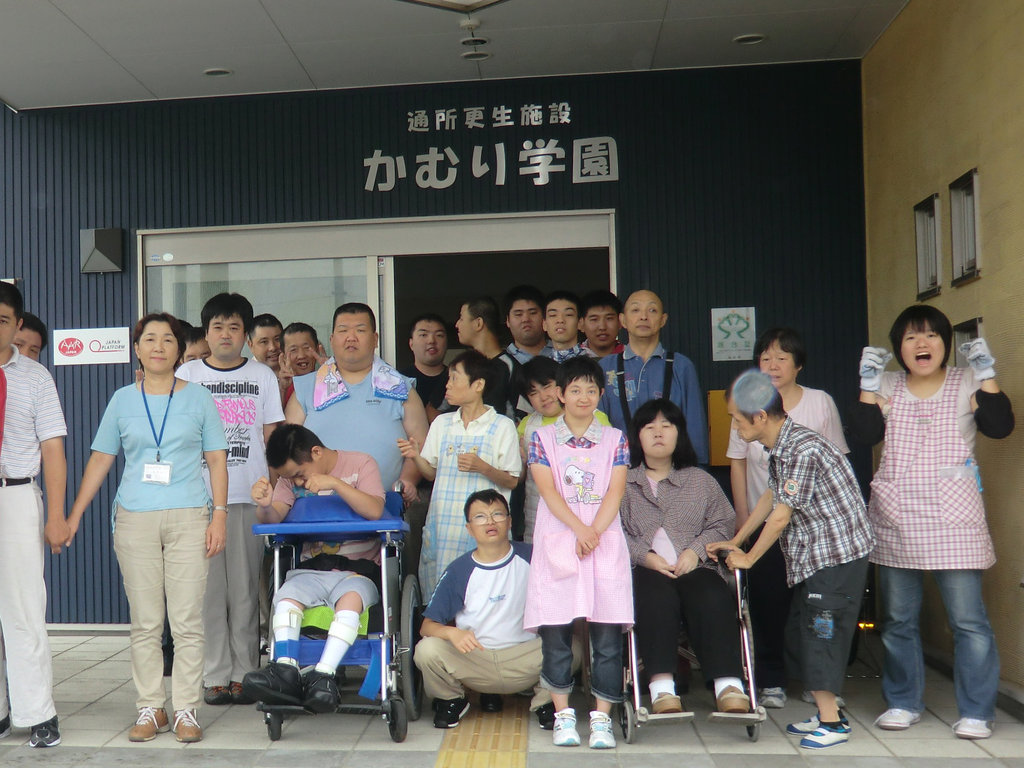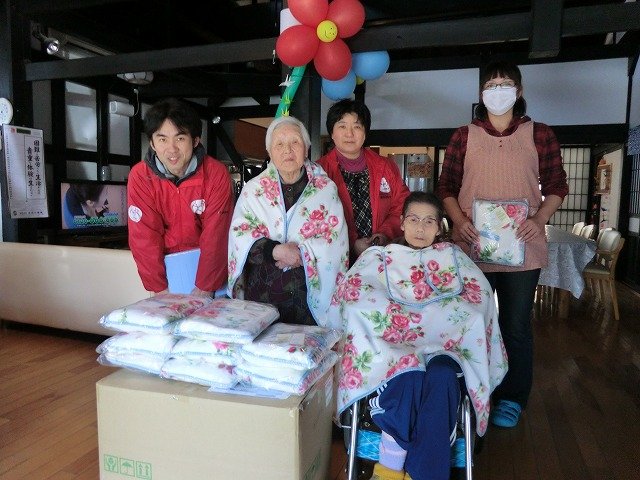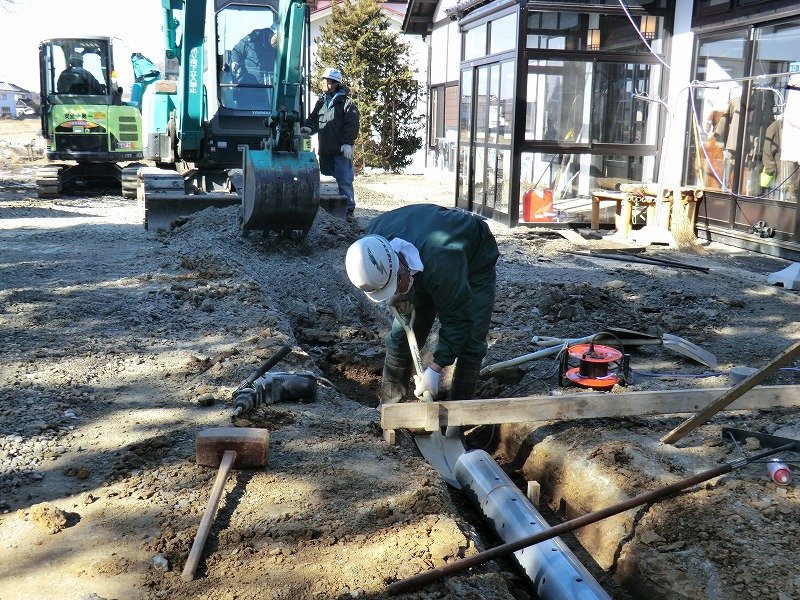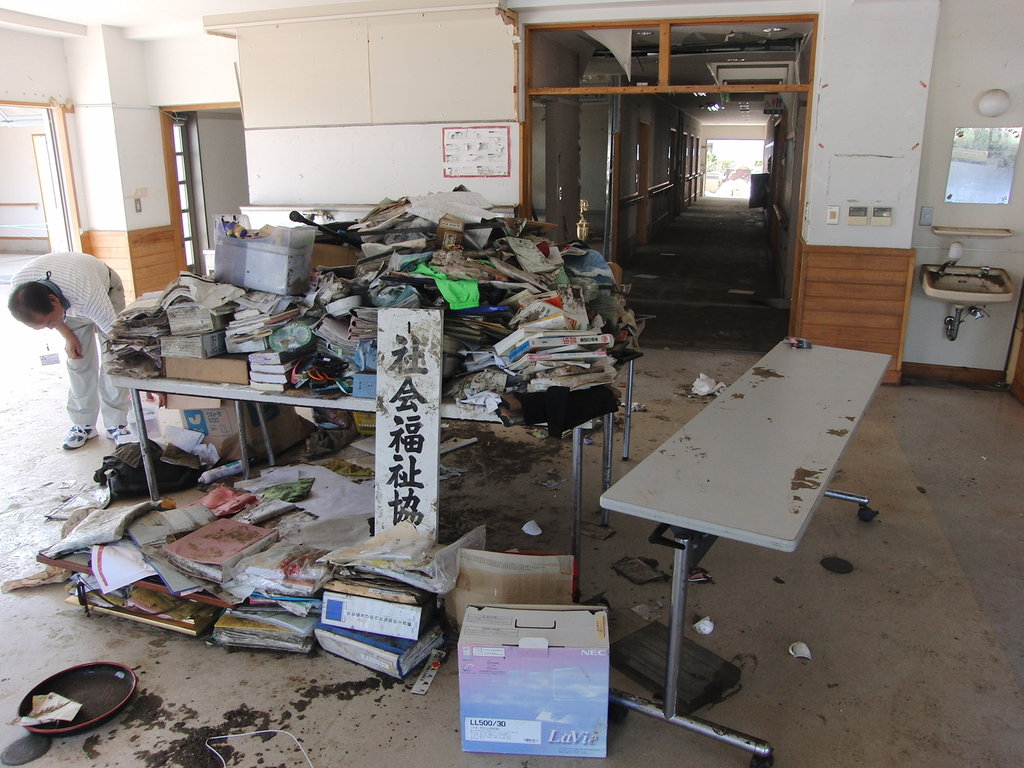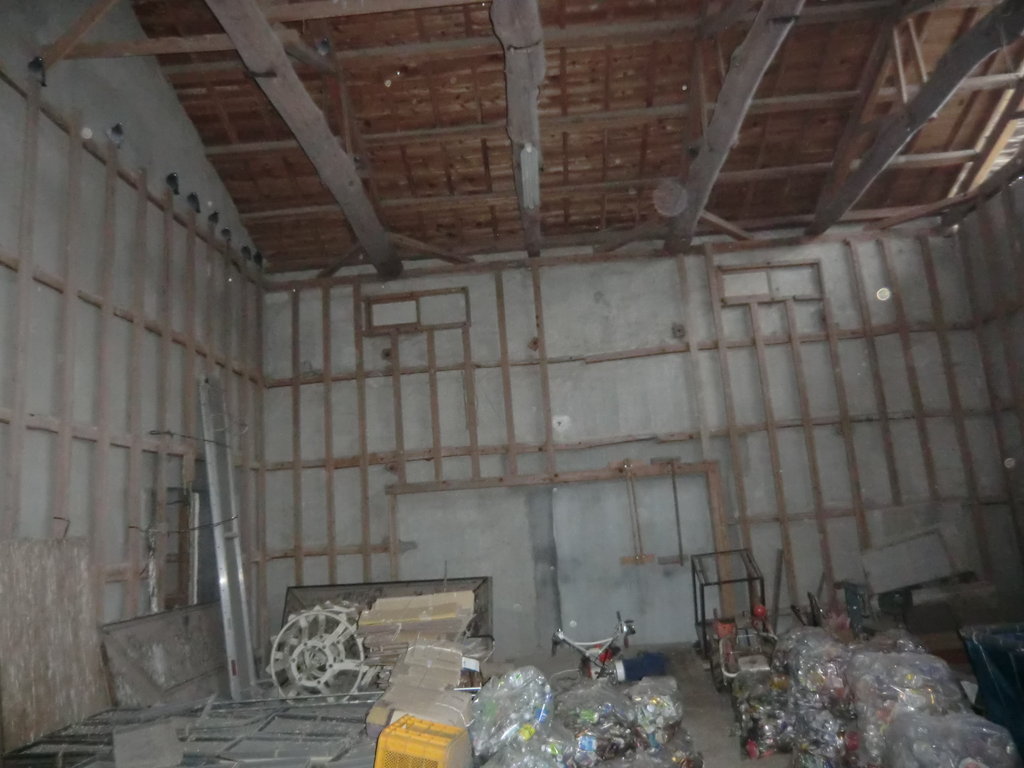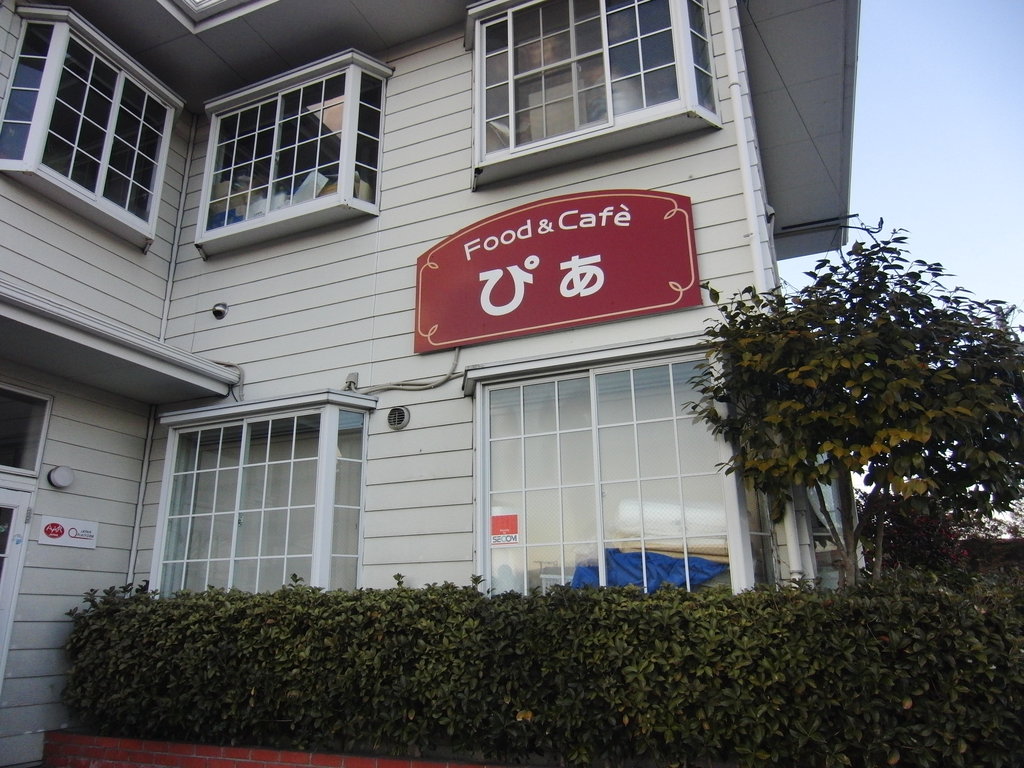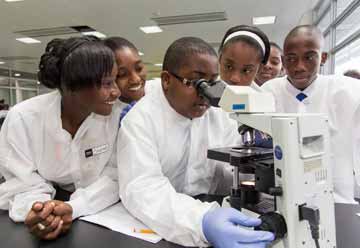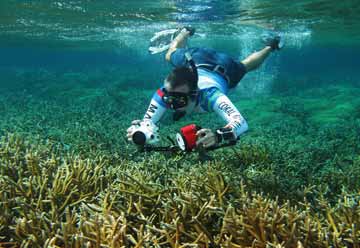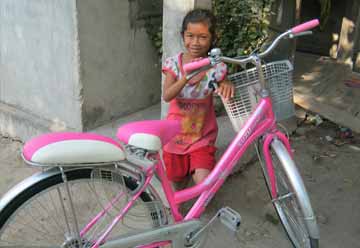Heartwarming Stew

April 5th - Delivering beef stew to more than 400 people at Utatsu Junior High School, which is being used as an evacuation center in Minami-Sanriku Town.
In addition to sending relief supplies to areas affected by the Great East Japan Earthquake, AAR JAPAN is also working in coordination with the Peace Project to operate soup kitchens at evacuation centers in Miyagi Prefecture. The Peace Project is a charity program jointly organized by Ingram Co., Ltd. and AAR JAPAN, in which AAR JAPAN receives a portion of sales from various items bearing Ingram’s licensed “Peace Mark”.
On April 5
th, AAR JAPAN’s Emergency Relief Team prepared approximately 500 servings of beef stew for people taking refuge in an evacuation center at UtatsuJunior High School in Minami-Sanriku Town, Miyagi Prefecture. In addition to those living in the school, we called out to people still living in the surrounding houses, gathering together a total of over 400 people. Our beef stew had taken many hands and a full night to prepare, and it was well-received by the disaster victims, approximately 100 of whom came back for more helpings until they were fully satisfied.

April 5th - Children holding a cardboard sign that reads, “Thank you very much – Everybody at Utatsu Evacuation Center, Minami-Sanriku Town.”
After she had eaten, a 70-year old woman said, “I’m sad because I lost my house, but this stew has warmed my heart.”
A 60-year old man said, “I want people to see the situation here and inform as many people as possible.” He added, “It may take a long time, but in two or three years I’d like to invite all the people involved in the soup kitchen back to thank them.” Receiving these words of gratitude from the disaster victims was heart-warming for us all.
Asked what was now needed the most, a group of lively 15-year-old boys enjoying their stew answered, “Love.” When we told them that we had put lots of love into the stew, they declared in unison, “That’s why this is the best stew we’ve ever had!”
“I’m worried because I no longer have a home, but we’re getting through each day by making each other laugh and cheering each other up.” Hearing these words made us feel that we needed to keep sending even more support and even more smiles to the disaster victims.
 April 5th – Many hands were involved in preparing the soup kitchen (Minami-Sanriku Town)
April 5th – Many hands were involved in preparing the soup kitchen (Minami-Sanriku Town)
April 5th - Messages from disaster victims written on the Emergency Relief Team’s flag: “We’ll reopen the school for sure!”, “It was delicious! I’m really grateful for the meal.” (Minami-Sanriku Town)
April 9th - AAR JAPAN staff Yukako Niimi (left) with 2nd year high school students from the baseball team who helped with the soup kitchen (Wakabayashi Gymnasium in Wakabayashi District, Sendai City)
April 9th –Delivering around 235 meals of yakisoba noodles and fried chicken, we heard people comment happily, "It’s the first yakisoba noodles we’ve been able to eat since the disaster.” (Wakabayashi District, Sendai City)
Numerous Survivors Stay in Half-Destroyed Homes

April 11th - A beach where surfers used to gather is now a scene of destruction (Shichigahama, Miyagi Prefecture)
One month has passed since the Great East Japan Earthquake, and while relief has now begun to meet demands on the ground, survivors staying outside official evacuation centers are still not getting all that they need.
It is estimated that roughly half of survivors have chosen to stay in their own homes, while many others have remained outside official evacuation centers by taking refuge with friends or relatives. AAR JAPAN is committed to reaching these evacuees, who often find themselves overlooked by the general relief effort.
Efforts to Reach the Neediest

April 11th - Hachiko Itoh (left) talks to Michitaka Kobayashi of AAR JAPAN (right) in front of her house. Having lost its support columns, the building seems to be in danger of collapse (Shichigahama, Miyagi Prefecture)
AAR JAPAN received word of thirty survivors taking refuge in their homes or with friends in Shichigahama, Miyagi Prefecture. Upon learning that they were hard-pressed for food and daily necessities, AAR JAPAN delivered supplies including rice, fermented soy bean paste, oranges, milk, toothbrushes, soap, clothes, side dishes, stove burners and high-pressure washers on Monday, April 11th, 2011.
With seven beaches in a row, Shichigahama was once a gathering spot for surfers coming from both within Miyagi Prefecture and without. The tsunami washed away the entire town, taking everything from the fishery facilities to private houses, post offices, convenience stores and restaurants. Farmland has also been submerged under seawater.
We came across a number of exhausted survivors cleaning their mud- and seawater-covered homes, carrying belongings they had picked up from among the rubble. Moving heavy furniture is a strenuous job for the elderly and for those living alone, and we spotted a few young local men carrying a large closet from an elderly person’s half-destroyed house. When we talked to people staying in friends’ or relatives’ less-damaged houses, one man said, “They have been feeding me, and I’m sorry to be a burden.”
Junko Sato lived close to the port, and when the tsunami hit, the first floor of her house was flooded. She has finally cleared all the mud after a month of hard labor, during which time she stayed at her sister’s house. Nevertheless, mud and seawater still remain under the floor, and the wooden house will rot if left as it is. Apprehensive of the future, she said, “I’ve already asked a business to take care of it, but I wonder when I can move back in.”
Hachiko Itoh lived in the hard-hit Yogasakihama area of Shichigahama. The first floor of her house was damaged to such an extent that it’s incredible that it has not collapsed to the ground. When we spoke to her, Hachiko was gathering memorabilia while using a towel to wipe the small piece of floor that survived the disaster. Her family has asked her to leave the site alone out of concern for her safety.

April 12th- People were very pleased to see when we returned to Shichigahama the next day with supplies including milk and oranges (Shichigahama, Miyagi Prefecture).
The survivors continue to face significant difficulties whether in homes or in evacuation centers. When we announced the successful delivery of our supplies, we were told that, although many organizations had been contacted for help, AAR JAPAN was the first to reach the Shichigahama area.
AAR JAPAN will continue to provide prompt and vital aid to those who are not being reached by the general relief effort.
AAR JAPAN has been making efforts to support hard-to reach disaster survivors who remain in their homes. On April 11th, AAR JAPAN’s Ayumi YASUDA delivered supplies to two homes in Ishinomaki City. This is her report.
There’s food in town, but…
In Daikaido, Ishinomaki City, we delivered diapers and wet wipes, baby food, toys, children’s clothes, milk, juice, high-pressure washers and boots to about 30 kindergartners and people who have remained in their homes in the neighborhood of Eiko Church and Eiko Kindergarten.
Although her car and furniture were swept away by the tsunami, church member Tomiyo HOSOKAWA has remained in her house. Her gas was finally reconnected the day before (the 10th), but the bath in her house is broken, so she has been bathing at her neighbors’ houses.
There are many people in the area who escaped from the Ojika Peninsula, which suffered tremendous damage from the earthquake and tsunami. Many fled with nothing but the clothes on their backs, and they have been relying on relatives in the area.
One month has passed since the earthquake, and access to food is improving, with some shops reopening and relief supplies being provided at evacuation centers. But people still lack cars with which to acquire supplies, and even those who can get ingredients may have nothing with which to cook them.

Tomiyo HOSOKAWA (right) said happily, “People who escaped from the Ojika Peninsula with little children have been waiting for these diapers.” (Left: AAR’s Ayumi YASUDA.)
Working to prevent the isolation of the elderly
Miyako SAITO is an elementary school teacher in Fudo-cho, Ishinomaki City. We delivered supplies to her house as requested, including milk, juice, garbage bags, mouthwash (used in place of tooth-brushing), antiseptic gel, moisture cream, and so on.
Located at the mouth of a river, Fudo-cho was significantly affected by the tsunami. Electricity and water have finally been restored, but gas has yet to be reconnected, and people have been using temporary bath-houses built by the Self-Defense Force.
Ms. SAITO said, “The problem we’re facing is that elderly people living alone tend to be isolated. They have no means of letting others know when they’re in trouble.” Ms. SAITO and her neighbors have divided the area into several groups so that each group’s leader can bring supplies back from evacuation centers for distribution to elderly survivors. “Normally neighbors would do more to care for the eld
Links:
![Share on Twitter]()
![Share on Facebook]()








